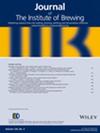下载PDF
{"title":"酒花风土对啤酒风味的影响","authors":"Ann Van Holle, Hilde Muylle, Geert Haesaert, Dirk Naudts, Denis De Keukeleire, Isabel Roldán-Ruiz, Anita Van Landschoot","doi":"10.1002/jib.648","DOIUrl":null,"url":null,"abstract":"<p>Not only variety but also terroir may have a significant impact on the biochemical and brewing characteristics of hops and, consequently, on the resulting beer flavour profile. To date, in contrast to variety-specific effects, comprehensive research data on the impact of terroir on hop brewing characteristics are limited. Therefore, the relevance of hop terroir was further explored with three industrially important hop varieties by examining the consequences of terroir-driven variations in hop characteristics on the sensory attributes and qualities of beer. Eight single-hop beers were produced with T90 hop pellets from distinct cultivation regions worldwide: (<i>i</i>) Amarillo hops grown in Germany, Idaho, or Washington, (<i>ii</i>) Cascade hops grown in Australia, Germany, or Washington, and (<i>iii</i>) Centennial hops grown in Belgium or Washington. Clear biochemical and sensory differences were found between single-hop beers produced with hop pellets of the same variety cultivated in distinct geographical regions. It was confirmed that terroir-related characteristics of hop batches affect the sensory attributes of beer and that the effects are variety dependent. These insights may allow brewers to account for the impact of hop terroir on the consistency and the quality of their beers, while it may open perspectives for subtle diversification in beer flavour profiles. Additional research should further unravel the link between terroir-related hop characteristics and the hoppy aroma and flavour of the resulting beers. © 2021 The Institute of Brewing & Distilling</p>","PeriodicalId":17279,"journal":{"name":"Journal of The Institute of Brewing","volume":null,"pages":null},"PeriodicalIF":2.4000,"publicationDate":"2021-03-30","publicationTypes":"Journal Article","fieldsOfStudy":null,"isOpenAccess":false,"openAccessPdf":"https://sci-hub-pdf.com/10.1002/jib.648","citationCount":"10","resultStr":"{\"title\":\"Relevance of hop terroir for beer flavour\",\"authors\":\"Ann Van Holle, Hilde Muylle, Geert Haesaert, Dirk Naudts, Denis De Keukeleire, Isabel Roldán-Ruiz, Anita Van Landschoot\",\"doi\":\"10.1002/jib.648\",\"DOIUrl\":null,\"url\":null,\"abstract\":\"<p>Not only variety but also terroir may have a significant impact on the biochemical and brewing characteristics of hops and, consequently, on the resulting beer flavour profile. To date, in contrast to variety-specific effects, comprehensive research data on the impact of terroir on hop brewing characteristics are limited. Therefore, the relevance of hop terroir was further explored with three industrially important hop varieties by examining the consequences of terroir-driven variations in hop characteristics on the sensory attributes and qualities of beer. Eight single-hop beers were produced with T90 hop pellets from distinct cultivation regions worldwide: (<i>i</i>) Amarillo hops grown in Germany, Idaho, or Washington, (<i>ii</i>) Cascade hops grown in Australia, Germany, or Washington, and (<i>iii</i>) Centennial hops grown in Belgium or Washington. Clear biochemical and sensory differences were found between single-hop beers produced with hop pellets of the same variety cultivated in distinct geographical regions. It was confirmed that terroir-related characteristics of hop batches affect the sensory attributes of beer and that the effects are variety dependent. These insights may allow brewers to account for the impact of hop terroir on the consistency and the quality of their beers, while it may open perspectives for subtle diversification in beer flavour profiles. Additional research should further unravel the link between terroir-related hop characteristics and the hoppy aroma and flavour of the resulting beers. © 2021 The Institute of Brewing & Distilling</p>\",\"PeriodicalId\":17279,\"journal\":{\"name\":\"Journal of The Institute of Brewing\",\"volume\":null,\"pages\":null},\"PeriodicalIF\":2.4000,\"publicationDate\":\"2021-03-30\",\"publicationTypes\":\"Journal Article\",\"fieldsOfStudy\":null,\"isOpenAccess\":false,\"openAccessPdf\":\"https://sci-hub-pdf.com/10.1002/jib.648\",\"citationCount\":\"10\",\"resultStr\":null,\"platform\":\"Semanticscholar\",\"paperid\":null,\"PeriodicalName\":\"Journal of The Institute of Brewing\",\"FirstCategoryId\":\"97\",\"ListUrlMain\":\"https://onlinelibrary.wiley.com/doi/10.1002/jib.648\",\"RegionNum\":3,\"RegionCategory\":\"农林科学\",\"ArticlePicture\":[],\"TitleCN\":null,\"AbstractTextCN\":null,\"PMCID\":null,\"EPubDate\":\"\",\"PubModel\":\"\",\"JCR\":\"Q3\",\"JCRName\":\"FOOD SCIENCE & TECHNOLOGY\",\"Score\":null,\"Total\":0}","platform":"Semanticscholar","paperid":null,"PeriodicalName":"Journal of The Institute of Brewing","FirstCategoryId":"97","ListUrlMain":"https://onlinelibrary.wiley.com/doi/10.1002/jib.648","RegionNum":3,"RegionCategory":"农林科学","ArticlePicture":[],"TitleCN":null,"AbstractTextCN":null,"PMCID":null,"EPubDate":"","PubModel":"","JCR":"Q3","JCRName":"FOOD SCIENCE & TECHNOLOGY","Score":null,"Total":0}
引用次数: 10
引用
批量引用


